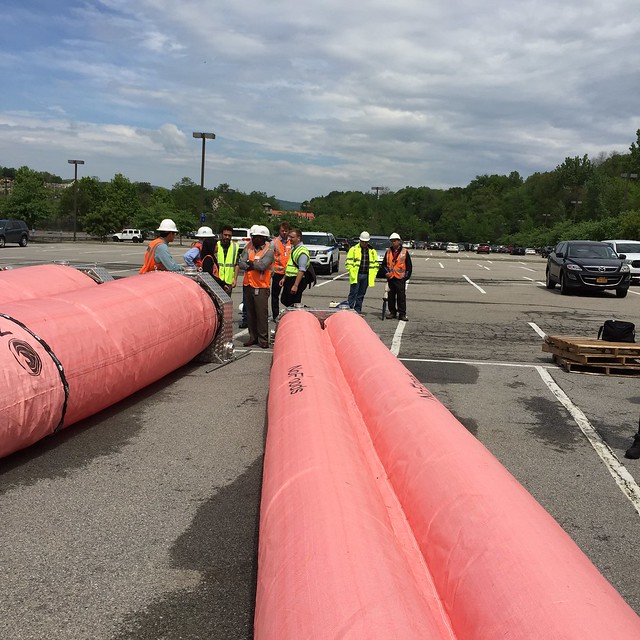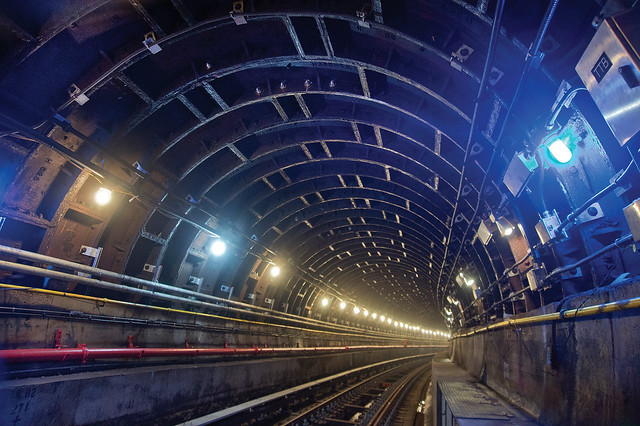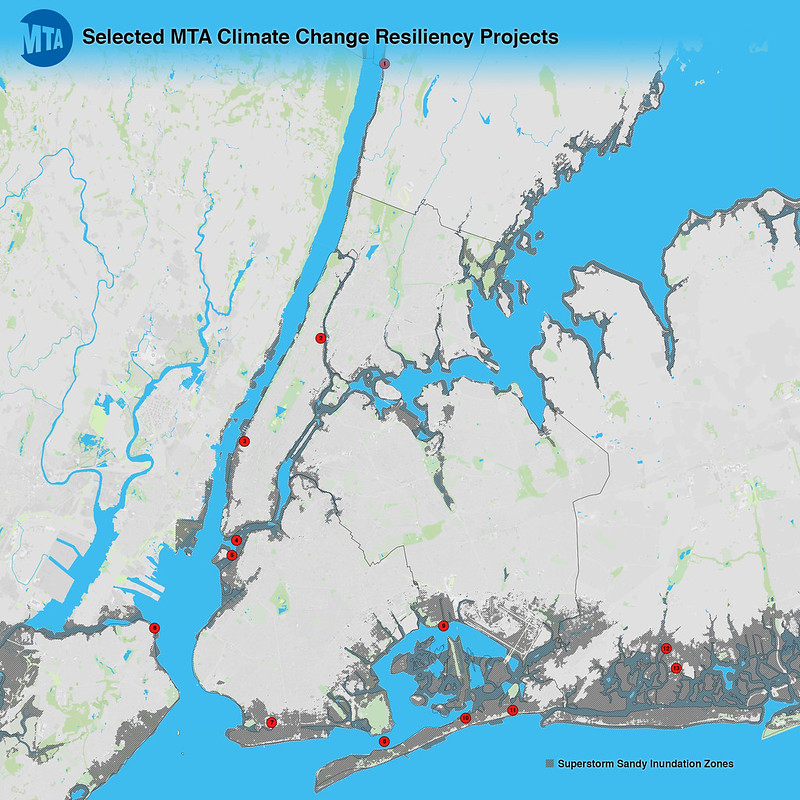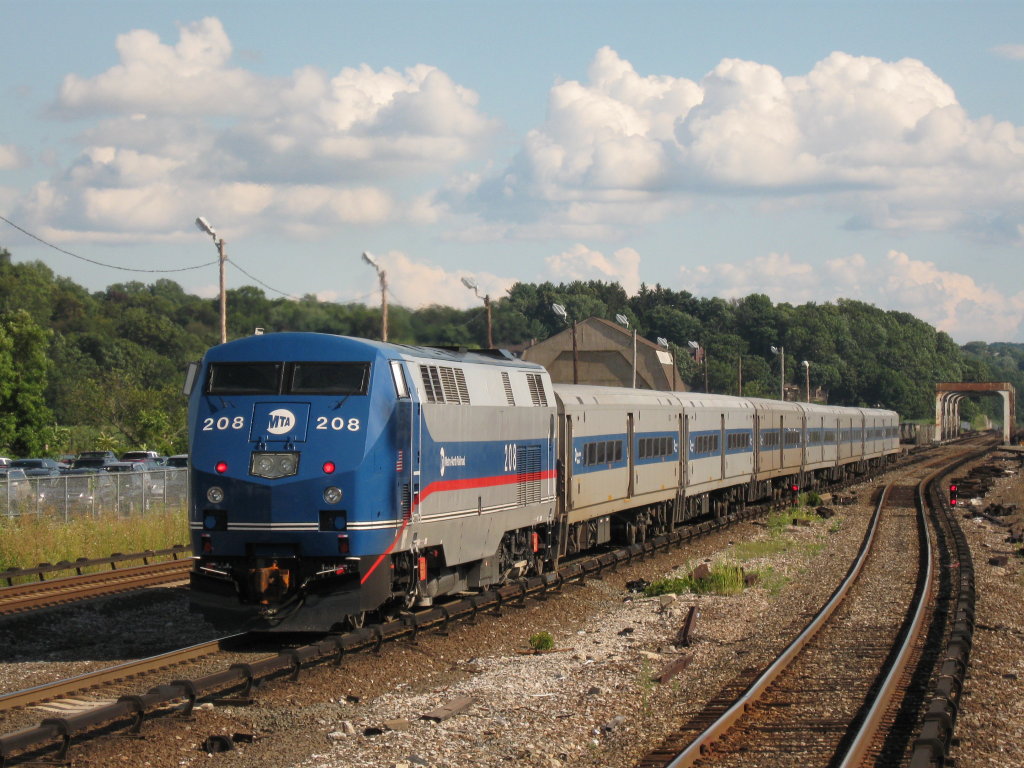The Metropolitan Transportation Authority cited the “urgent reality” of climate change in a new report on public transit projects that are preparing for sea level rise, storm surges and other climate-related dangers to this coastal region. MTA Interim Executive Director Ronnie Hakim also reminded tri-state-area residents of the environmental benefits of choosing mass transit, encouraging the public to think about sustainability long after Earth Day, and throughout the year.
“For the MTA, climate change is not only an urgent reality, it is a reality to which all six MTA agencies are already devoting extensive financial, planning, and engineering resources,” according to the MTA’s first annual Climate Adaptation Task Force Resiliency Report, which was released today and available for download at mta.info/sustainability. “There is no responsible alternative. The science of climate change is well established.”
“Earth Day was Saturday but every day is Earth Day at the MTA,” Hakim said. “Mass transit is the original ridesharing. We remove some 3 million drivers from the roads each day and every person that rides a train or a bus is adding five times less greenhouse gas emissions to the environment than someone driving a car. Simply riding mass transit is a major contribution to the environment, and every MTA customer should be proud of their role in saving the planet and our future.”
TRANSIT SUSTAINABILITY FACTS:
Regularly taking mass transit is one of the best ways that an individual can help the environment.
- By removing some 3 million drivers from the roads each day, the MTA prevents more carbon emissions from the atmosphere than 648,000 acres of forest can absorb.
- Riding a bus or train emits five times less carbon emissions into the atmosphere than driving a car.
- Every day you commute using the MTA, you help keep more than 20 pounds of carbon emissions from entering the atmosphere.
- Transit reduces traffic congestion significantly, saving billions of dollars annually for the regional economy.
- Transit’s contribution to improving traffic flow reduces fuel costs, vehicle operating costs and costs associated with traffic accidents.
- Transit helps enable more compactly clustered residential and commercial development, which reduces commuting time, land use, energy consumption, building costs and reliance upon automobiles.
- The MTA is using state of the art “green” technology in many of its current and future building projects – from LED lighting at stations and on bridges to fully LEED-certified buildings using green roofs, solar walls, heat recovery units, rainwater collection, recycled water systems and recycled building materials.
- At the Bridges & Tunnels Battery Parking Garage in Lower Manhattan, the conversion of 1,561 light fixtures to LED is allowing an annual savings of 1.3 million kilowatt hours of electricity – a cost savings of $160,000 per year and an annual reduction of 685 tons of carbon dioxide emissions – the equivalent of saving 70,000 gallons of gasoline from being used.
- The Fulton Center is Silver LEED certified, with features including day-lighting, water efficient fixtures, and more than 50 percent of its energy usage coming from renewable sources. The project was constructed using recycled and regional materials and more than 75 percent of the project’s construction waste was diverted from landfills.
- The new Second Avenue Subway uses such green features such as LED signage, energy efficient tunnel fans, efficient tunnel shape to improve natural ventilation, and even track elevation changes designed to allow trains to rely on gravity to help speed up and slow down.
- Newly enhanced stations across the New York City Transit, Long Island Rail Road and Metro-North systems will incorporate LED lighting and other environmentally friendly features, such as push-to-heat outdoor platform shelter technology.
PREPARING FOR CLIMATE CHANGE
The MTA Resiliency Report is the first of annual updates from the MTA’s Climate Adaptation Task Force, which was formed after Superstorm Sandy and continues to meet regularly with MTA agency staff and experts from outside organizations. The report offers a view of the MTA’s efforts to prepare for climate change and related emergencies – efforts such as the fortification of tunnels with moving marine doors, the use of portable flood walls that can be moved to critical areas as needed, and the permanent elevation of flood-exposed signal, power and communications equipment.
Using sources such as the U.S. Army Corps of Engineers, the New York State Energy Research and Development Authority and the New York City Panel on Climate Change, the MTA projects sea levels to rise between 8 and 30 inches in the New York City region by the 2050s, putting a vast amount of MTA’s assets, which are at grade level or underground, at risk of flooding and damage.
Average temperatures in the region are projected to rise between 3.1 and 6.6 degrees Fahrenheit by the 2050s, increasing stresses on rails, switches and air conditioning, as well as increasing the risk of brownouts and blackouts.
Precipitation and extreme winds are also projected to increase due to climate change, causing additional risk of flooding and downed trees disrupting rail service.
The MTA’s transportation network and infrastructure assets cover 5,000 square miles of service territory and 2,069 track miles, all of which are impacted by various, often compounded, climate change hazards. Large portions of the MTA transportation network consist of aging infrastructure, and because of the coastal location of many MTA assets, the potential impacts from coastal inundation are significant.
MTA’s agencies — Long Island Rail Road, Metro-North Railroad, NYC Transit (including Staten Island Railway), and Bridges and Tunnels — have identified 46 major capital projects focused on climate resiliency that have either been recently completed or are underway. They are valued at approximately $3 billion in total. The Resiliency Report highlights many of them, including:
Long Island Rail Road
- Flood protection measures on Long Beach Branch including raising and hardening power, signal and communication systems
- Hardened West Side and Long Island City Yards
- Designed deployable flood barriers at Queens Portal
- Atlantic Avenue Tunnel Mitigation Project

LIRR’s Long Beach Branch signal, power and communications are being fully replaced and elevated above flood levels or hardened in place with flood-resistant materials and techniques.
Metro-North Railroad
- Flood protection measures along the Hudson Line including water level monitoring and raising of substations.
- Flood mitigation for facilities at Croton-Harmon Yard and Highbridge Yard.
- Perimeter protection of buildings including flood doors and barriers.

Metro-North personnel attend a demonstration of a portable floodwater retention system.
New York City Transit
- Montague Tube Restoration Project includes repaired tube and corrosion resistant duct banks and cabling.
- New pump trains increased pumping capacity
- SIR’s Clifton shop and St. George station made resilient to high water table with recycled plastic cross-ties.
- Hardening of Coney Island shop
- Green roof at Mother Clara Hale Bus Depot
- Installation of flood wall along Broad Channel

Bridges & Tunnels
- Flood protection measures for Hugh L. Carey Tunnel and the Queens Midtown Tunnel
- Raising of substations and critical equipment at Rockaway bridges (Marine Parkway Bridge and Cross Bay Bridge).

1. Metro-North Substations & Breaker Houses: Sandy-damaged electrical facilities substantially raised and rebuilt at higher elevation to avoid future flood damage.
2. NYCT Subway 148th Street Portal: Specially designed “logs” to span 24’ across portal opening where 3 Train emerges from the ground at 148th Street, to keep out flood waters.
3. NYCT Bus Depot: Deploying flex walls or swing gates at Michael J. Quill Bus Depot on the far west side, to prevent future flood water ingress.
4. NYCT Subway Montague Street Tube: Brand new duct banks, high capacity pumps, marine grade cabling for badly damaged Montague Street under river subway tube.
5. Bridges & Tunnels: Hugh L. Carey Tunnel rapidly returned to usability after being completely unpassable after Sandy. Damaged internal finishes, electrical and communications systems replaced. Permanent flood barrier at portals ongoing.
6. NYCT St. George Terminal: Replace traditional timber railroad ties, vulnerable to rotting thanks to high water table, with recycled plastic crossties. Enhancing climate resilience and acoustic performance.
7. NYCT Subway Coney Island Yard: 3 miles of interim perimeter flood protection for surges up to FEMA 100-year flood elevation + 2’ of safety. Permanent, and taller, protection in design phase.
8. Rebuilt Marine Parkway-Gil Hodges Memorial Bridge, which suffered significant damage from Sandy. Erosion damage, electrical equipment & lighting repaired. Shoreline and abutments fortified. Substations being replaced above 500-year flood elevations.
9. NYCT Subway Rockaway Line: Extensive clearing of debris and repairs along the Rockaway line, quickly restoring full service. Sheet pile going 30’ below ground and 10’ above to protect the line from future storms.
10. Rebuilt Cross Bay Bridge, which suffered significant damage from Sandy. Erosion damage, electrical equipment & lighting repaired. Shoreline and abutments fortified. Substations being replaced above 500-year flood elevations.
11. NYCT Bus Far Rockaway Bus Depot: A new, more resilient Far Rockaway Bus Depot is being constructed with passive flood mitigations and water-resistant materials. Old depot was particularly low-lying and surge-vulnerable facility; new depot will be protected from 500-year flood levels.
12. LIRR: Long Beach Branch signal, power and communications being fully replaced and elevated above flood levels or hardened in place with flood-resistant materials and techniques.
13. LIRR: 3 Long Beach Branch substations, powering third rail for electrical traction, being newly built and raised to above future flood levels.


